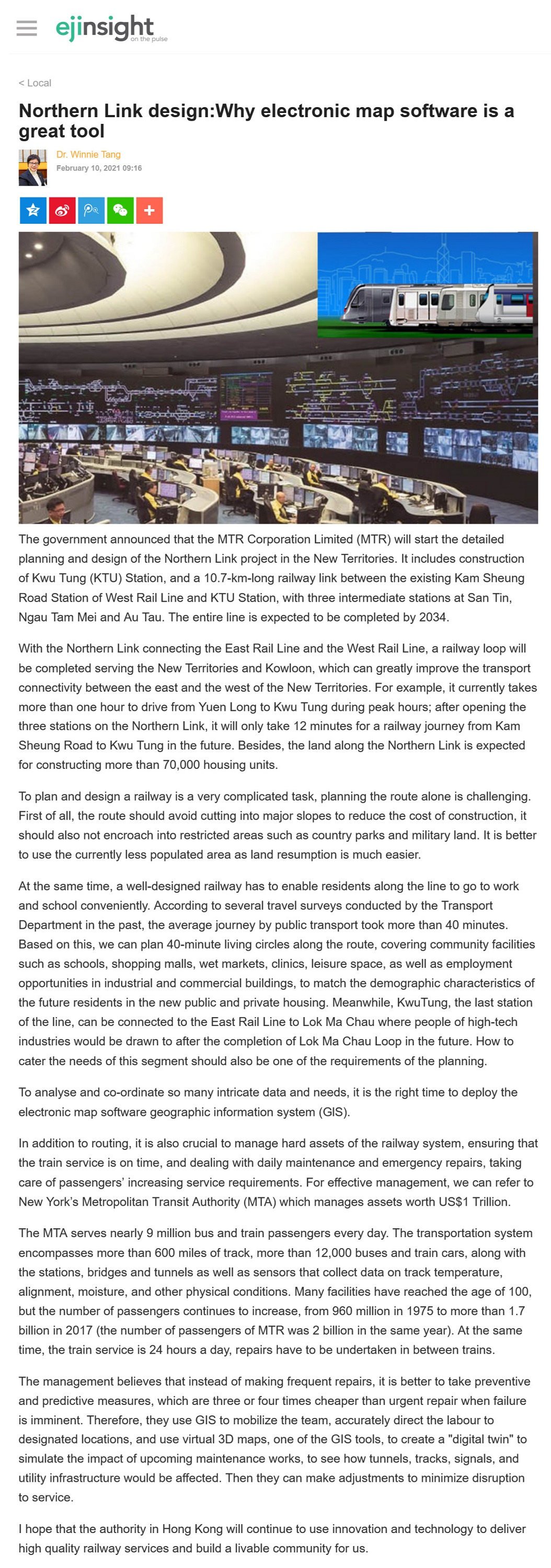網上版請按此

Northern Link design : Why electronic map software is a great tool
The government announced that the MTR Corporation Limited (MTR) will start the detailed planning and design of the Northern Link project in the New Territories. It includes construction of Kwu Tung (KTU) Station, and a 10.7-km-long railway link between the existing Kam Sheung Road Station of West Rail Line and KTU Station, with three intermediate stations at San Tin, Ngau Tam Mei and Au Tau. The entire line is expected to be completed by 2034.
With the Northern Link connecting the East Rail Line and the West Rail Line, a railway loop will be completed serving the New Territories and Kowloon, which can greatly improve the transport connectivity between the east and the west of the New Territories. For example, it currently takes more than one hour to drive from Yuen Long to Kwu Tung during peak hours; after opening the three stations on the Northern Link, it will only take 12 minutes for a railway journey from Kam Sheung Road to Kwu Tung in the future. Besides, the land along the Northern Link is expected for constructing more than 70,000 housing units.
To plan and design a railway is a very complicated task, planning the route alone is challenging. First of all, the route should avoid cutting into major slopes to reduce the cost of construction, it should also not encroach into restricted areas such as country parks and military land. It is better to use the currently less populated area as land resumption is much easier.
At the same time, a well-designed railway has to enable residents along the line to go to work and school conveniently. According to several travel surveys conducted by the Transport Department in the past, the average journey by public transport took more than 40 minutes. Based on this, we can plan 40-minute living circles along the route, covering community facilities such as schools, shopping malls, wet markets, clinics, leisure space, as well as employment opportunities in industrial and commercial buildings, to match the demographic characteristics of the future residents in the new public and private housing. Meanwhile, KwuTung, the last station of the line, can be connected to the East Rail Line to Lok Ma Chau where people of high-tech industries would be drawn to after the completion of Lok Ma Chau Loop in the future. How to cater the needs of this segment should also be one of the requirements of the planning.
To analyse and co-ordinate so many intricate data and needs, it is the right time to deploy the electronic map software geographic information system (GlS).
In addition to routing, it is also crucial to manage hard assets of the railway system, ensuring that the train service is on time, and dealing with daily maintenance and emergency repairs, taking care of passengers’ increasing service requirements. For effective management, we can refer to New York’s Metropolitan Transit Authority (MTA) which manages assets worth US$1 Trillion.
The MTA serves nearly 9 million bus and train passengers every day. The transportation system encompasses more than 600 miles of track, more than 12,000 buses and train cars, along with the stations, bridges and tunnels as well as sensors that collect data on track temperature, alignment, moisture, and other physical conditions. Many facilities have reached the age of 100, but the number of passengers continues to increase, from 960 million in 1975 to more than 1.7 billion in 2017 (the number of passengers of MTR was 2 billion in the same year). At the same time, the train service is 24 hours a day, repairs have to be undertaken in between trains.
The management believes that instead of making frequent repairs, it is better to take preventive and predictive measures, which are three or four times cheaper than urgent repair when failure is imminent. Therefore, they use GIS to mobilize the team, accurately direct the labour to designated locations, and use virtual 3D maps, one of the GIS tools, to create a "digital twin" to simulate the impact of upcoming maintenance works, to see how tunnels, tracks, signals, and utility infrastructure would be affected. Then they can make adjustments to minimize disruption to service.
I hope that the authority in Hong Kong will continue to use innovation and technology to deliver high quality railway services and build a livable community for us.
Dr. Winnie Tang
Adjunct Professor, Department of Computer Science, Faculty of Engineering; Department of Geography, Faculty of Social Sciences; and Faculty of Architecture, The University of Hong Kong